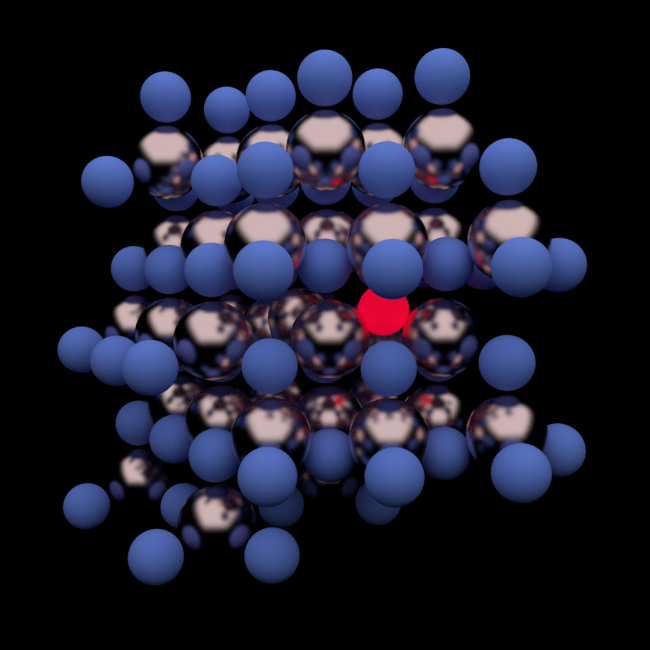A brief review of books concerning point defects in materials. There are many more, but these 4000 pages form a good start...
(Figure by Adam Jackson using Blender)
Electronic Processes in Ionic Crystals (275 pages)
N. F. Mott and R. W. Gurney (1940)
- A text that is as fresh and relevant now as it was then. It covers the ionic lattice, defect equilibria, electron stability, as well as photovoltaic and photochemical processes. The most amazing thing you get from reading this book is how little our basic understanding has advanced in the subsequent 70 years.
Rating: 4 Vacancies
The Chemistry of Imperfect Crystals (1619 pages)
F. A. Kröger (1964; 1974)
- The bible of defective crystals. Since the notation of Kröger and Vink is ubiquitous in defect chemistry, you can imagine the seminal role they played in its development. This book conveys the range of experiments and theory that have been developed to study defective crystals, and most importantly, provides an encyclopaedic list of results and references. The second edition comes in three volumes: growth, imperfections and non-equilibrium process. Not for the faint hearted!
Rating: 4 Vacancies + 1 Interstitial
Theory of Defects in Solids (976 pages)
A. M. Stoneham (1975)
- The preface lighly states that the perfect crystal is a work of science fiction. What follows is an epic tour de force. It is a difficult read, even with occasional comic relief thanks to the author's dry English humour. The amount of information contained in the volume is incredible. I won't claim to have read it all, but I find it a very valuable source of information.
Rating: 4 Anti-sites
Defects and Defect Processes in Nonmetallic Solids (441 pages)
W. Hayes and A. M. Stoneham (1985)
- This work updates and clarifies many of the basic concepts from the first Stoneham monolith. It manages to be both accessible and in-depth, covering everything from basic electronic structure and interatomic force models to a detailed account of defect spectroscopy. It also tackles surfaces and radiation-induced defect processes. I learned a lot reading this.
Rating: 4 Vacancies
Defect Chemistry of Metal Oxides (289 pages)
D. M. Smyth (2000)
- The grey hardback cover with silver text gives this book a certain elegance even before opening. It contains a light but solid discussion of the basics of defect chemistry with many specific oxide examples. It would be the perfect text to accompany a lecture course (well referenced with plenty examples and problems for each chapter). The "chemistry" focus results in a simple description of electronic defects, but a much stronger description of ionic defects and the effect of environment, with worked examples for TiO2, NiO, CoO and BaTiO3. An ideal introductory text.
Rating: 3 Vacancies
Defects in Solids (494 pages)
R. J. D. Tilley (2008)
- Yet another epic piece of writing. The book is tailored towards an advanced lecture course (each chapter has a Q&A section), which in principle should add extra clarity, but ends up making the discussion a little dry and soulless. It shares a lot of content with the above book by Smyth (oxide focused mass action approach with plenty of Brouwer diagrams), which is actually a much better read and almost half the size.
Rating: 1 Vacancy
Any other suggestions?
